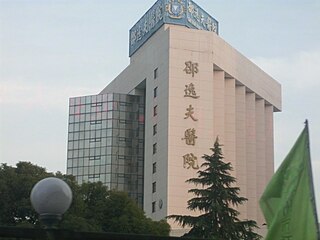Related Research Articles

Sanya is the southernmost city on Hainan Island, and one of the four prefecture-level cities of Hainan Province in South China.

Healthcare in China has undergone basic changes over the twentieth century and twenty-first centuries, using both public and private medical institutions and insurance programs. As of 2020, about 95% of the population has at least basic health insurance coverage. Basic medical insurance includes two systems: employee medical insurance and resident medical insurance. The former covers the urban employed population, and the latter covers the urban non-employed population and the rural population. A total of 25% of the people covered by the basic medical insurance participated in the employee medical insurance, a total of 344 million people; 75% participated in the residents' medical insurance, a total of 1.017 billion people. Medical assistance has subsidized 78 million poor people to participate in basic medical insurance, and the coverage of poor people has stabilized at over 99.9%. Despite this, public health insurance generally only covers about half of medical costs, with the proportion lower for serious or chronic illnesses. Under the "Healthy China 2020" initiative, China has undertaken an effort to cut healthcare costs, requiring insurance to cover 70% of costs by the end of 2018. In addition, there are policies such as critical illness insurance and medical assistance. China's commercial health insurance is also proliferating. In 2020, the country's commercial health insurance premium income amounted to 817.3 billion yuan, with an average annual growth rate of 20%. China's coverage of maternity insurance has continued to expand, by the end of 2020, 235.673 million people were insured under maternity insurance.

The Second Affiliated Hospital of Zhejiang University School of Medicine, known as Kwang Chi Hospital before 1952, is a non-for-profit tertiary care public hospital in Hangzhou, Zhejiang, China. Founded as a drug rehabilitation clinic in 1869 by the British Church Missionary Society, it is one of the oldest hospitals in Zhejiang to offer Western medicine and one of the leading medical centres in China.

Sir Run Run Shaw Hospital, or Shao Yifu Hospital, is a hospital affiliated with the Medical School of Zhejiang University, in Hangzhou, Zhejiang, China.

Wu Jingyu is a female Chinese Taekwondo practitioner who won gold medals at the 2008 and 2012 Summer Olympics in the –49 kg class. She also won several medals at world championships and Asian Games.

Zhang, Zhaohuan (张照寰) was born in Zhenjiang, China, in 1925. He graduated from the Faculty of Medicine, Shanghai Medical College in 1950. Because of his outstanding school performance and academic potential, he was offered a lectureship by his alma mater upon graduation—a practice that is still in vogue in almost all universities in China when recruiting exceptional faculty members is difficult. In the eight years that followed, he worked there first as a lecturer and then an associate professor and associate director.
Longgan Lake is a freshwater lake in central China, divided between Susong County of Anhui Province and Huangmei County at the eastern extremity of Hubei Province. The lake is situated near the north bank of the middle reaches of Yangtze River, opposite Poyang Lake. The lake was named Longgan Lake in a 1955 decision which combined the names of two former lakes, Long Lake (龙湖) and Gan Lake (感湖).
The Nanjing General Hospital of People's Liberation Army, formerly Nanjing General Hospital of Nanjing Military Command, or Nanjing General Hospital, The Military General Hospital, is also known as Jinling Hospital which used to be Central Hospital. NGH is located at 305 Zhongshan East Road, Nanjing, Jiangsu Province, China. It is a large comprehensive teaching hospital integrating medical services with teaching and research.

Lǐ is a Chinese surname. In Mandarin it is pronounced with the dipped third tone of the four tones.
Violence against doctors and other medical practitioners in China has been reported as an increasing problem. National Ministry of Health statistics indicate that the number of violent incidents against hospitals and medical staff increased from about 10,000 in 2005 to more than 17,000 in 2010. A survey by the Chinese Hospital Association reported an average of 27.3 assaults per hospital per year in 2012, up from 20.6 assaults per hospital per year in 2006. In 2012, an editorial in The Lancet described the situation as a "crisis" for the practice of medicine in China.

The Children's Hospital of Fudan University is a national-level tertiary children's hospital in Shanghai, China. It is a university hospital affiliated to Fudan University Shanghai Medical College. The hospital is located in Minhang District with an outpatient clinic located in Xuhui District.
Sichuan Provincial Women's Prison is a women's prison in Yangma Town (养马镇), Jianyang, Chengdu, Sichuan, 50 kilometres (31 mi) away from the center of Chengdu. It is over 20,000 square metres (0.020 km2) large. It became a women's prison in 1998. The Sichuan Provincial Administration of Prisons operates this facility.

Zhao Shuai is a Chinese taekwondo practitioner. He won gold medals at the 2016 Olympics and 2017 World Championships, placing third earlier in 2015. He served as the flag bearer for China at the opening ceremony of the 2018 Asian Games, where he later won a silver medal.
Zheng Shuyin is a Chinese taekwondo athlete.

Huashan Hospital, Past was called for Chinese Red Cross General Hospital is founded by Red Cross Soiecty of China in 1907, It is the district general hospital by Red Cross Soiecty of China in Shanghai, China, Huashan Hospital affiliated with the Shanghai Medical College of Fudan University.

Huadong Hospital or East China Hospital, founded in 1921 as the Country Hospital, is a teaching hospital in Shanghai, China, affiliated with the Shanghai Medical College of Fudan University. Its main building, designed by László Hudec, is a Municipal Heritage Building of Shanghai.
The Dabie Mountain Regional Medical Centre is a hospital campus in Huangzhou District, Huanggang, Hubei, China. Originally constructed as a new campus for the eventual relocation of Huanggang Central Hospital, it was rapidly converted into a quarantine facility as a response to the COVID-19 pandemic which originated in Wuhan.
The COVID-19 pandemic in Hubei, part of the global COVID-19 pandemic, was the first identified outbreak of the pandemic, appearing as a cluster of mysterious pneumonia in Wuhan, the provincial capital of Hubei, China. A Wuhan hospital notified the local Center for Disease Control and Prevention (CDC) and health commissions on December 27, 2019. On December 31, Wuhan CDC admitted that there was a cluster of unknown pneumonia cases related to the Huanan Seafood Wholesale Market after the unverified documents appeared on the Internet. The outbreak soon drew nationwide attention, with the National Health Commission (NHC) in Beijing sending medical experts to Wuhan the next day. On January 8, a new coronavirus was identified as the cause of the pneumonia. The sequence of the virus was soon published on an open-access database. Measures taken by China have been controversial. They were praised by the World Health Organization (WHO) for improvements over SARS-CoV-2 responses, but maligned by many in the international community for being slow to publicly disclose key facts or deceptive about the outbreak and for aggressively censoring information related to the outbreak and public discontent from citizens online.

The Beijing Xiaotangshan Recovery Hospital, also known as the Beijing Xiaotangshan Hospital, is a tertiary-level general hospital in Xiaotangshan Township, Changping District, Beijing, China, occupying approximately 33 hectares of land.

A COVID-19 outbreak in the city of Shanghai, China began on February 28, 2022, and ended on August 7, 2022. The outbreak was caused by the Omicron variant and became the most widespread in Shanghai since the pandemic began two years prior. Authorities responded with mass COVID-19 testing and a strict lockdown of the city in an effort to uphold China's zero-COVID policy; the latter marked the largest one in the country since the lockdown of Hubei in early 2020. The outbreak caused substantial economic and social disruption across Shanghai with consequences felt elsewhere, and led to the spread of COVID-19 to other parts of China, including Beijing, Guangdong, and Hunan.
References
- ↑ Guo ZH: Hospital Management. 1990, Beijing, People's Health Publishing House
- 1 2 Li, Xingming; Huang, Jianshi; Zhang, Hui (2008). "An analysis of hospital preparedness capacity for public health emergency in four regions of China: Beijing, Shandong, Guangxi, and Hainan". BMC Public Health. 8: 319. doi: 10.1186/1471-2458-8-319 . PMC 2567325 . PMID 18803860.
- ↑ Zhang, W.; Deng, Z.; Evans, R.; Xiang, F.; Ye, Q.; Zeng, R. (August 9, 2018). "Social Media Landscape of the Tertiary Referral Hospitals in China: Observational Descriptive Study". J Med Internet Res. 20 (8): e249. doi: 10.2196/jmir.9607 . PMC 6107732 . PMID 30093370.
- ↑ China's National Health and Family Planning Commission; China Health Statistical Yearbook, 2008
- ↑ "Yunnan Public Health Insurance Information Service: Medicare FAQs". Archived from the original on April 25, 2012. Retrieved October 11, 2011.,
- ↑ "China sets up new system to optimize medical resources". China Daily. September 16, 2015.
- ↑ "医改进程(上):曾经的全额公费医疗,为什么现在消失了?" [Process of Healthcare reform, part I: the free healthcare of old, why is it gone now?]. 中国网--网上中国. 2011. Archived from the original on 2022-01-27.
计划经济时期的医院全部由政府管控,建立了我们现在较为熟知的三级医院结构,即城镇由市、区两级医院和街道、厂矿门诊组成的三级医疗服务及卫生防疫体系;农村以县医院为龙头、以乡(镇)卫生院为枢纽、以村卫生室为基础的三级医疗预防保健网络。所有的医疗设备、医务人员均由国家统一分配管理。
- ↑ Chinese minister of Health (November 1989). "s:cn:医院分级管理办法(试行草案) [Rules for classifying hospitals]"
- ↑ 刘庭芳 (September 2019). "我国医疗机构评审的制度变迁与路径选择". 中国卫生质量管理. 第18卷 (第5期). Archived from the original on 2018-11-01. Retrieved 2018-11-01.